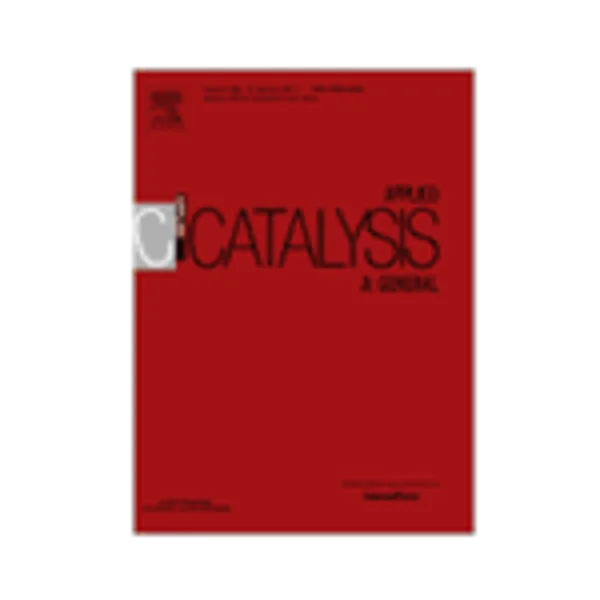-
ring opening of decalin via hydrogenolysis on ir/- and pt/silica catalysts
جزئیات بیشتر مقاله- تاریخ ارائه: 1392/07/24
- تاریخ انتشار در تی پی بین: 1392/07/24
- تعداد بازدید: 1363
- تعداد پرسش و پاسخ ها: 0
- شماره تماس دبیرخانه رویداد: -
the catalytic conversion of cis-decalin was studied at a hydrogen pressure of 5.2 mpa and temperatures of 250–410 °c on iridium and platinum supported on non-acidic silica. the absence of catalytically active brønsted acid sites was indicated by both ft-ir spectroscopy with pyridine as a probe and the selectivities in a catalytic test reaction, viz. the hydroconversion of n-octane. on iridium/silica, decalin hydroconversion starts at ca. 250–300 °c, and no skeletal isomerization occurs. the first step is rather hydrogenolytic opening of one six-membered ring to form the direct ring-opening products butylcyclohexane, 1-methyl-2-propylcyclohexane and 1,2-diethylcyclohexane. these show a consecutive hydrogenolysis, either of an endocyclic carboncarbon bond into open-chain decanes or of an exocyclic carbon
carbon bond resulting primarily in methane and c9 naphthenes. the latter can undergo a further endocyclic hydrogenolysis leading to open-chain nonanes. all individual c10 and c9 hydrocarbons predicted by this “direct ring-opening mechanism” were identified in the products generated on the iridium/silica catalysts. the carbon-number distributions of the hydrocracked products c9− show a peculiar shape resembling a hammock and could be readily predicted by simulation of the direct ring-opening mechanism. platinum on silica was found to require temperatures around 350–400 °c at which relatively large amounts of tetralin and naphthalene are formed. the most abundant primary products on pt/silica are spiro[4.5]decane and butylcyclohexane which can be readily accounted for by the well known platinum-induced mechanisms described in the literature for smaller model hydrocarbons, namely the bond-shift isomerization mechanism and hydrogenolysis of a secondary-tertiary carbon
carbon bond in decalin.
مقالات جدیدترین رویدادها
-
استفاده از تحلیل اهمیت-عملکرد در ارائه الگوی مدیریت خلاقیت سازمانی و ارائه راهکار جهت بهبود
-
بررسی تاثیر ارزش وجوه نقد مازاد بر ساختار سرمایه شرکت های پذیرفته شده در بورس اوراق بهادار تهران
-
بررسی تأثیر سطح افشای ریسک بر قرارداد بدهی شرکت های پذیرفته شده در بورس اوراق بهادار تهران
-
بررسی تأثیر رتبه بندی اعتباری مبتنی بر مدل امتیاز بازار نوظهور بر نقد شوندگی سهام با تأکید بر خصوصی سازی شرکت ها
-
تأثیر آمیخته بازاریابی پوشاک ایرانی بر تصویر ذهنی مشتری پوشاک ایرانی (هاکوپیان)
-
درس پژوهی یادگیری ساعت_ ربع و نیم ریاضی دوم
-
معرفی جاذبه های طبیعی استان گیلان مطالعه موردی شهرستان رضوانشهر
-
بررسی آزمایشگاهی تاثیر آب شکن فرعی قائم بر آب شستگی دماغه ی اولین آب شکن
-
turbulent forced convection heat transfer of non-newtonian nanofluids
-
facile fabrication of recoverable and stable superhydrophobic polyaniline films
مقالات جدیدترین ژورنال ها
-
مدیریت و بررسی افسردگی دانش آموزان دختر مقطع متوسطه دوم در دروان کرونا در شهرستان دزفول
-
مدیریت و بررسی خرد سیاسی در اندیشه ی فردوسی در ادب ایران
-
واکاوی و مدیریت توصیفی قلمدان(جاکلیدی)ضریح در موزه آستان قدس رضوی
-
بررسی تاثیر خلاقیت، دانش و انگیزه کارکنان بر پیشنهادات نوآورانه کارکنان ( مورد مطالعه: هتل های 3 و 4 ستاره استان کرمان)
-
بررسی تاثیر کیفیت سیستم های اطلاعاتی بر تصمیم گیری موفق در شرکتهای تولیدی استان اصفهان (مورد مطالعه: مدیران شرکتهای تولیدی استان اصفهان)
-
ارتباط ارزهای دیجیتال با اوراق بهادار
-
استراتژی توسعه شهر شیروان با رویکرد توسعه پایدار
-
طراحی مدلی برای شناسایی فرصت های کارآفرینی در مناطق بندری
-
مطالعه و بررسی تکنیک های سرد تزیین آثار شیشه ای
-
بررسی فرهنگ سازمانی معلمان ابتدایی




سوال خود را در مورد این مقاله مطرح نمایید :